信号与线性系统课程设计答案
信号与线性系统分析_(吴大正_第四版)习题答案12264精编版
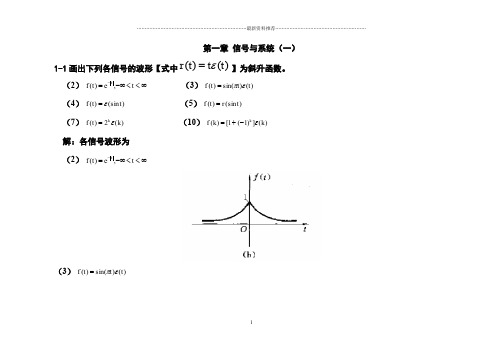
第一章 信号与系统(一)1-1画出下列各信号的波形【式中)()(t t t r ε=】为斜升函数。
(2)∞<<-∞=-t e t f t ,)( (3))()sin()(t t t f επ= (4))(sin )(t t f ε= (5))(sin )(t r t f = (7))(2)(k t f k ε= (10))(])1(1[)(k k f k ε-+= 解:各信号波形为 (2)∞<<-∞=-t e t f t ,)((3))()sin()(t t t f επ=(4))fεt=(sin)(t(5))trf=(sin)(t(7))t(kf kε=)(2(10))f kεk-=(k+(])1(1[)1-2 画出下列各信号的波形[式中)()(t t t r ε=为斜升函数]。
(1))2()1(3)1(2)(-+--+=t t t t f εεε (2))2()1(2)()(-+--=t r t r t r t f(5))2()2()(t t r t f -=ε (8))]5()([)(--=k k k k f εε(11))]7()()[6sin()(--=k k k k f εεπ (12))]()3([2)(k k k f k---=εε 解:各信号波形为 (1))2()1(3)1(2)(-+--+=t t t t f εεε(2))2()1(2)()(-+--=t rt rt rtf(5))2()2()(ttrtf-=ε(8))]5()([)(--=k k k k f εε(11))]7()()[6sin()(--=k k k k f εεπ(12))]()3([2)(kkkf k---=εε1-3 写出图1-3所示各波形的表达式。
1-4 写出图1-4所示各序列的闭合形式表达式。
1-5 判别下列各序列是否为周期性的。
如果是,确定其周期。
(2))63cos()443cos()(2ππππ+++=k k k f (5))sin(2cos 3)(5t t t f π+=解:1-6 已知信号)(t f 的波形如图1-5所示,画出下列各函数的波形。
信号与线性系统课后答案

2 -2 求图题 2-1 各电路中响应 i0(t)和 u0(t)对激励 f (t)的传输算子 H( p)。
解: (a) Hu f
( p)
u0 (t) f (t)
375 3p 625
;
Hi f
( p)
i0 (t) f (t)
7.5 104 p 3p 625
;
(b) Hu f ( p)
u0 (t) f (t)
0 A1 A2 cos A3
A1 0
1
2A2 (cos
A3
sin
A3 )
A2
0.5
y(t) 0.5e2t sin 2t , t 0 .
0 4A2 2 cos A3
A3 90
(3) p1 0, p2, 3 2 , y(t) A1 ( A2t A3)e2t ,
0 A1 A3
f (t),
y(0- ) 2,
y(0- ) 1;
(2)
y(t)
(2 p 1) p( p2 4 p 8)
f (t),
y(0- ) 0,
y(0- ) 1,
y(0- ) 0 ;
(3) y(t)
3p 1 p( p 2)2
f (t),
y(0- ) y(0- ) 0,
y(0- ) 4 .
ux ' (0 )
i(0 ) C
0
5 0
A1 A2 2 A1
3A2
A1 15, A2 10, ux (t) 15e2t 10e3tV, t 0 .
(b)
Y( p)
0
1 1
p
1 1
p
0
p2
2p
2
0
p1 1 j1, p2 1 j1 ix (t) A1et cos(t A2 )
信号与线性系统课后习题答案1
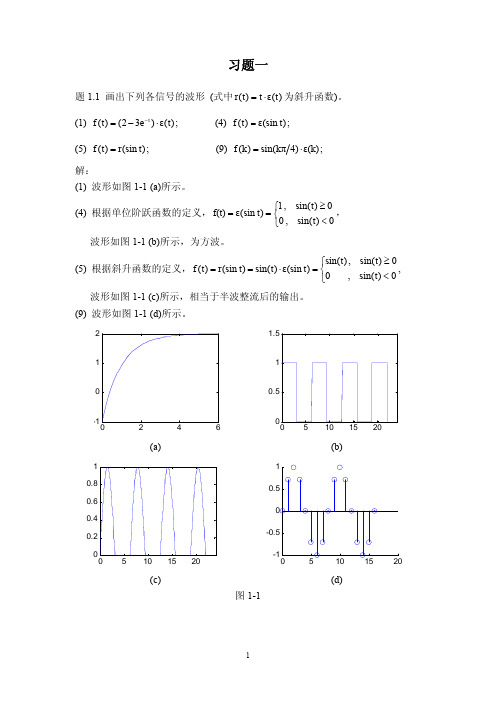
3
(2) 利用 f (t)δ′(t) = f (0)δ′(t) − f ′(0)δ(t)
原式 = (1 − t)
(6) 利用 δ(at) =
∞
d [ δ(t)] = (1 − t)δ′(t) = 1⋅ δ′(t) − (−1) ⋅ δ(t) = δ′(t) + δ(t) dt
1 δ(t) a
t =0
0
2
t
图 1-5 题 1.7 已知信号的波形如图 1-6 所示,分别画出 f (t) 、 f ′(t) 的波形。 解:信号运算及波形演变过程如图 1-6 所示。
图 1-6 题 1.8 计算下列各题。 (1) d2 { [cos t + sin(2t)] ε(t)} ; dt 2
t 2 ∫−∞ (t + 2)δ( 2 )dt ;
−∞
t
t
∴ yf (t) = ∫ e
−∞
−2x
ε (x) dx = ∫ e
0
t
−2x
e −2x dx = − 2
t
=
0
1 (1 − e−2t )ε(t) 2
题 1.25 某 LTI 连续系统,其初始状态一定。 已知当激励为 f (t) 时,其全响应为 y1 (t) = e − t + cos( πt) , t ≥ 0 ; 若初始状态不变,激励为 2f (t) 时,其全响应为 y 2 (t) = 2 cos( πt) , t ≥ 0 ; 求初始状态不变,而激励为 3f (t) 时系统的全响应。 解:设系统的零输入响应为 y x (t) ,激励为 f (t) 时对应的零状态响应为 yf (t) 。
图 1-2
(2) f (t) = [ r(t) − r(t − 1) ] − [ r(t − 1) − r(t − 2) ] ; r(t)、r(t − 1) 波形如图 1-3 (a)所示, 设 p(t) = r(t) − r(t − 1) ,则 p(t)、p(t − 1) 波形如图 1-3 (b)、(c)所示, f (t) = p(t) − p(t − 1) 波形如图 1-3 (d) 所示。
信号与线性系统课后习题答案4
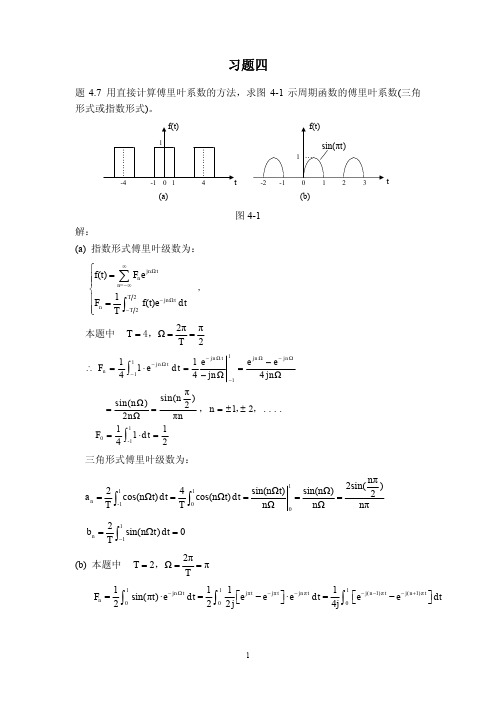
即: 1 =
(3) 平均功率 p =
∴ 电压有效值 =
(4) Q Fn =
2
1 T2 1 1 − jn π t 1 − e − jn π − jn π t f(t)e dt = e dt = , n = ±1, ±2..... T ∫− T 2 2 ∫0 j2nπ
∴ Fn F0 =
=
1 − e − jn π j2nπ
1
1 ⎡1 − e − j(n −1) π 1 − e − j(n +1) π ⎤ 1 + (−1) n ∴ Fn = ⎢ − ⎥= 4 j ⎣ j(n − 1) π j(n + 1) π ⎦ 2 π(1 − n 2 )
题 4.11 某 1 Ω 电阻两端的电压 u(t) 如图 4-2 所示
u/V
1
−2t FT ⎡ ⎣ e ε ( t + 1) ⎤ ⎦ =
∫
∞ −∞
e − 2 t ε ( t + 1) e − j ω t d t =
∫
∞ −1
e − ( jω + 2 ) t d t =
e jω + 2 jω + 2
(5) Q ε(t) ↔ πδ(ω) +
⎡ 1 1⎤ e − jω , ∴ ε(t − 1) ↔ e − jω ⎢ πδ(ω) + ⎥ = πδ(ω) + jω jω ⎦ jω ⎣
∴ u(t) =
令 n = 2k + 1, k = 0,1,2...... ,则
u(t) = = 1 ∞ 2 sin [ (2k + 1) πt ] +∑ 2 k =0 (2k + 1) π 1 2 ∞ 1 sin [ (2k + 1) πt ] + ∑ 2 π k =0 (2k + 1) π 1 1 , 而 u( ) = 1 2 2
东华大学信号与线性系统课程设计答案

东华⼤学信号与线性系统课程设计答案答案东华⼤学信号与线性系统课程设计班级:学号:姓名:东华⼤学信息学院⽬录实验⼀连续信号的时域分析 (3)实验⼆连续时间系统的时域分析 (8)实验三连续信号的频域分析 (14)实验四连续系统的频域分析 (22)实验五信号采样与重建 (33)实验六离散时间信号和系统分析 (39)实验总结 (46)实验⼀连续信号的时域分析⼀、实验⽬的1、熟悉MATLAB 软件。
2、掌握常⽤连续信号与离散信号的MATLAB 表⽰⽅法。
⼆、实验设备安装有matlab6.5 以上版本的PC 机⼀台。
三、实验原理四、实验内容1、⽤MATLAB表⽰连续信号:tAe ,Acos(ω0 t +?),Asin(ω0 t +?)。
源程序:clcclearclosesyms t;f1=2*exp(t);f2=2*cos(3*t+4);f3=2*sin(3*t+4);subplot(2,2,1);ezplot(f1,[-10,2]);title('f(t)=2e^t');grid on;subplot(2,2,2);ezplot(f2,[-5,5]);xlabel('t');title('f(t)=2cos(3t+4)');grid on;subplot(2,2,3);ezplot(f3,[-5,5]);xlabel('t');title('f(t)=2sin(3t+4)');grid on2、⽤MATLAB表⽰抽样信号(sinc(t))、矩形脉冲信号(rectpuls(t, width)) 及三⾓脉冲信号(tripuls(t, width, skew))。
源程序:clcclearcloset=-5:0.01:5;f1=sinc(t);f2=3*rectpuls(t,4);f3=3*tripuls(t,4,0);subplot(2,2,1);plot(t,f1);xlabel('t');title('f(t)=sinc(t)');grid on;subplot(2,2,2)plot(t,f2);xlabel('t');title('f(t)=3rectpuls(t,4)');grid on;axis([-5,5,-1,4]);subplot(2,2,3);xlabel('t');title('f(t)=3rectpuls(t,4,0)');grid on;axis([-5,5,-1,4]);3、编写如图3 的函数并⽤MATLAB 绘出满⾜下⾯要求的图形。
信号与线性系统分析-(吴大正-第四版)习题答案第二章

第二章2-1 已知描述系统的微分方程和初始状态如下,试求其零输入响应。
(1)1)0(',1)0(),()(6)('5)(''-===++-y y t f t y t y t y(4)0)0(',2)0(),()()(''===+-y y t f t y t y2-2 已知描述系统的微分方程和初始状态如下,试求其+0值)0(+y 和)0('+y 。
(2))()(,1)0(',1)0(),('')(8)('6)(''t t f y y t f t y t y t y δ====++--(4))()(,2)0(',1)0(),(')(5)('4)(''2t e t f y y t f t y t y t y t ε====++--解:2-4 已知描述系统的微分方程和初始状态如下,试求其零输入响应、零状态响应和全响应。
(2))()(,2)0(',1)0(),(3)(')(4)('4)(''t e t f y y t f t f t y t y t y t ε---===+=++解:2-8 如图2-4所示的电路,若以)(t i S 为输入,)(t u R 为输出,试列出其微分方程,并求出冲激响应和阶跃响应。
2-12 如图2-6所示的电路,以电容电压)(tuC为响应,试求其冲激响应和阶跃响应。
2-16 各函数波形如图2-8所示,图2-8(b)、(c)、(d)均为单位冲激函数,试求下列卷积,并画出波形图。
(1))(*)(21t f t f (2))(*)(31t f t f (3))(*)(41t f t f(4))(*)(*)(221t f t f t f (5))3()(2[*)(341--t f t f t f波形图如图2-9(a)所示。
信号与线性系统-白恩健书答案

第1章基本概念K第1章习题k1.1解:(1)x(t)为周期信号,周期为T=10。
(2)x(t)为非周期信号。
(3)x[n]为非周期信号。
(4)x[n]为周期信号,周期为N=2。
(5)x(t)为非周期信号。
(6)x[n]为周期信号,周期为N=2。
1.2解:(1)x(t)为功率信号。
(2)x(t)既不是能量信号也不是功率信号。
(3)x[n]为能量信号。
(4)x(t)为能量信号。
(5)x(t)为能量信号。
(6)x[n]为能量信号。
1.3略。
1.4略。
1.5(原题有误)一个离散时间系统的激励与响应的关系为y[n]=M∑i=0b i x[n−i]。
用算符S−k代表将信号x[n]平移k个单位时间得到输出信号x[n−k]的系统,即x[n−k]=S−k(x[n])。
写出联系y[n]与x[n]的系统算符T及其可逆系统的算符T inv。
解:提示:可逆系统为y[n]−M∑i=1b i x[n−i]=b0x[n]。
1.6解:(1)因果、无记忆、非线性、时不变、BIBO稳定系统。
(2)因果、无记忆、线性、时变和BIBO稳定系统。
(3)因果、无记忆、线性、时变和非稳定系统。
(4)因果、记忆、线性、时不变和BIBO稳定系统。
(5)因果、无记忆、线性、时变和BIBO稳定系统。
(6)因果、记忆、时不变、非稳定系统。
–2/48–第1章基本概念(7)因果、无记忆、线性、时不变和BIBO稳定系统。
(8)非因果系统、无记忆、线性、时不变、BIBO稳定系统。
1.7证明略。
1.8解:(1)x[n]的响应为{1,1,−1,2,n=0,1,2,3}。
(2)x[n]的响应为{1,1,−3,1,3,−5,2,n=−3∼3}。
(3)x[n]的响应为{1,0,−1,4,−3,2,n=−2∼3}。
1.9证明提示:根据微积分的极限定义证明。
1.10解:(1)x(t)的响应为4(1−e−t)u(t)−6(1−e−t+1)u(t−1)。
(2)x(t)的响应为[2(t+e−t)−2]u(t)。
信号与线性系统分析_(吴大正_第四版)习题答案第六章
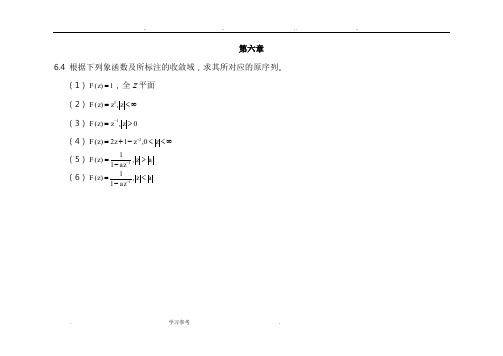
. 学习参考. 第六章6.4 根据下列象函数及所标注的收敛域,求其所对应的原序列。
(1)1)(=z F ,全z 平面(2)∞<=z z z F ,)(3(3)0,)(1>=-z z z F(4)∞<<-+=-z z z z F 0,12)(2(5)a z az z F >-=-,11)(1(6)a z az z F <-=-,11)(1. 学习参考.6.5 已知1)(↔k δ,az z k a k -↔)(ε,2)1()(-↔z z k k ε,试利用z 变换的性质求下列序列的z 变换并注明收敛域。
. 学习参考 .(1))(])1(1[21k k ε-+ (3))()1(k k k ε-(5))1()1(--k k k ε (7))]4()([--k k k εε(9))()2cos()21(k k k επ. 学习参考.6.8 若因果序列的z 变换)(z F 如下,能否应用终值定理?如果能,求出)(lim k f k ∞→。
(1))31)(21(1)(2+-+=z z z z F (3))2)(1()(2--=z z z z F. 学习参考.6.10 求下列象函数的双边逆z 变换。
(1)31,)31)(21(1)(2<--+=z z z z z F (2)21,)31)(21()(2>--=z z z z z F (3)21,)1()21()(23<--=z z z z z F. 学习参考 .(4)2131,)1()21()(23<<--=z z z z z F. 学习参考.. 学习参考.. 学习参考.. 学习参考.6.11 求下列象函数的逆z 变换。
(1)1,11)(2>+=z z z F (2)1,)1)(1()(22>+--+=z z z z z z z F (5)1,)1)(1()(2>--=z z z z z F (6)a z a z az z z F >-+=,)()(32. 学习参考.. 学习参考.. 学习参考.6.13 如因果序列)()(z F k f ,试求下列序列的z 变换。
信号与线性系统分析_(吴大正_第四版)习题答案
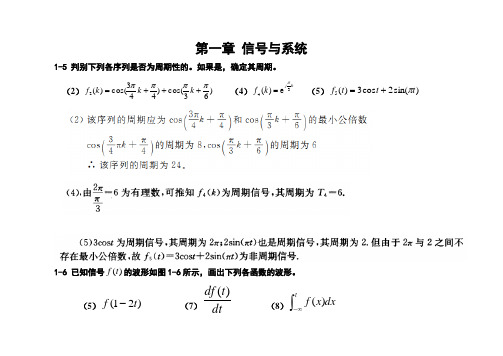
第一章 信号与系统1-5 判别下列各序列是否为周期性的。
如果是,确定其周期。
(2))63cos()443cos()(2ππππ+++=k k k f (4)k j k f 34e )(π= (5))sin(2cos 3)(5t t t f π+=1-6 已知信号)(t f 的波形如图1-6所示,画出下列各函数的波形。
(5))21(t f - (7)dtt df )( (8)dx x f t⎰∞-)(解:1-7 已知序列)(k f 的图形如图1-7所示,画出下列各序列的图形。
(1))()2(k k f ε- (3))]4()()[2(---k k k f εε1-10 计算下列各题。
(5)dt t tt )2()]4sin([2++⎰∞∞-δπ(6)dt t )2()2t (2δ⎰∞∞-+(7)dt t t t )1()12t 2('23-+-+⎰∞∞-δ1-23 设系统的初始状态为)0(x ,激励为)(⋅f ,各系统的全响应)(⋅y 与激励和初始状态的关系如下,试分析各系统是否是线性的。
(1)⎰+=-ttdx x xf x e t y 0)(sin )0()( (2)⎰+=tdx x f x t f t y 0)()0()()(1-23 设系统的初始状态为)0(x ,激励为)(⋅f ,各系统的全响应)(⋅y 与激励和初始状态的关系如下,试分析各系统是否是线性的。
(1)⎰+=-ttdx x xf x e t y 0)(sin )0()( (2)⎰+=tdx x f x t f t y 0)()0()()(1-27 某LTI 连续系统,其初始状态一定。
已知当激励为)t (1y 时,其全响应为0)cos()(1≥+-=t t t e t y π若初始状态不变,当激励为)(2t f 时,其全响应为0)cos(2)(2≥=t t t y π,若初始状态不变,当激励为)(3t f 时,求其全响应。
第二章2-1 已知描述系统的微分方程和初始状态如下,试求其零输入响应。
信号与线性系统课后习题答案2
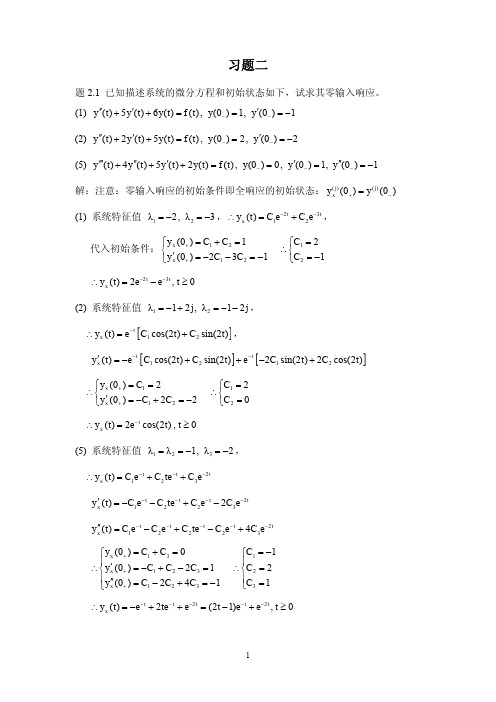
∞
t +3
τ2 τ dτ = 2
⋅ ε (t + 2)
1
题 2.24 某 LTI 系统, 其输入 f (t) 与输出 y(t) 的关系为 y(t) = ∫ e −2(t − x ) f (x − 2) dx ,
t −1
∞
求该系统的冲激响应 h(t) 。 解:令 f (t) = δ(t) ,则有
h(t) = ∫ e −2(t − x ) δ(x − 2) dx = e −2t ∫ e 2x δ(x − 2) dx = e−2(t − 2) ∫ δ(x − 2) dx
初始条件为 i′ f (0 + ) = i f (0 + ) = 0 齐次解为 C1e −2t + C2 e −3t ,设特解为 Pe − t 。将特解代入到方程,求出 P = 1
∴ i f (t) = C1e −2t + C2 e−3t + e− t ,由初始条件得到:
⎧C1 + C2 + 1 = 0 ⎧C1 = −2 ⇒ ⎨ ⎨ ⎩−2C1 − 3C2 − 1 = 0 ⎩C 2 = 1
(1) 系统特征值 λ1 = −2, λ 2 = −3 ,∴ y x (t) = C1e −2t + C2 e −3t ,
⎧ y (0 ) = C1 + C2 = 1 代入初始条件: ⎨ x + ⎩ y′ x (0 + ) = −2C1 − 3C 2 = −1 ⎧C1 = 2 ∴⎨ ⎩C2 = −1
Q u R (t) = R ⋅ i L2 (t) = 2i L2 (t) = 2∫ u L (t) dt 且 u R (t) + u L (t) = u L1 (t)
信号与线性系统分析_(吴大正_第四版)习题答案
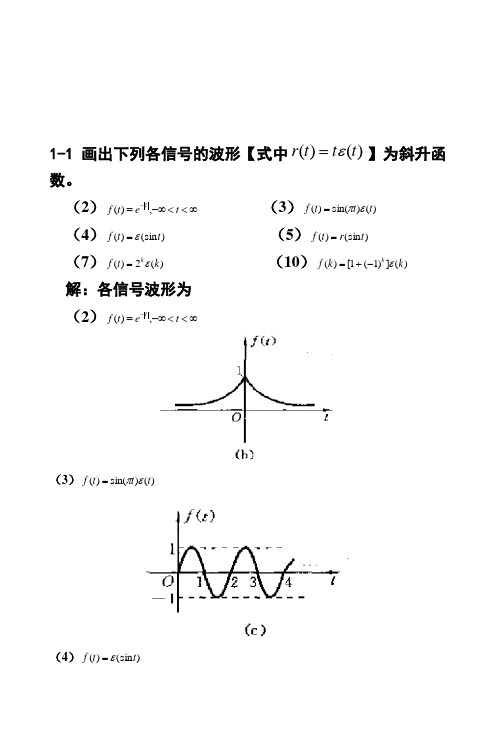
1-1画出下列各信号的波形【式中)()(t t t r ε=】为斜升函数。
(2)∞<<-∞=-t et f t,)( (3))()sin()(t t t f επ=(4))(sin )(t t f ε= (5))(sin )(t r t f = (7))(2)(k t f kε= (10))(])1(1[)(k k f kε-+=解:各信号波形为 (2)∞<<-∞=-t et f t,)((3))()sin()(t t t f επ=(4))(sin )(t t f ε=(5))f=rt)(sin(t(7))t=(kf kε(2)(10))f kεk=(k+-((])1)1[1-2 画出下列各信号的波形[式中)()(t t t r ε=为斜升函数]。
(1))2()1(3)1(2)(-+--+=t t t t f εεε (2))2()1(2)()(-+--=t r t r t r t f(5))2()2()(t t r t f -=ε (8))]5()([)(--=k k k k f εε(11))]7()()[6sin()(--=k k k k f εεπ(12))]()3([2)(k k k f k ---=εε解:各信号波形为(1))2()1(3)1(2)(-+--+=t t t t f εεε(2))2()1(2)()(-+--=t r t r t r t f(5))2()2()(t t r t f -=ε(8))]5()([)(--=k k k k f εε(11))]7()()[6sin()(--=k k k k f εεπ(12))]()3([2)(k k k f k---=εε1-3 写出图1-3所示各波形的表达式。
1-4 写出图1-4所示各序列的闭合形式表达式。
1-5 判别下列各序列是否为周期性的。
如果是,确定其周期。
(2))63cos()443cos()(2ππππ+++=k k k f (5))sin(2cos 3)(5t t t f π+=解:1-6 已知信号)(t f 的波形如图1-5所示,画出下列各函数的波形。
信号与线性系统分析-(吴大正-第四版)第三章习题答案

第三章习题3.1、试求序列k 01(k)=2f ⎧⎪⎛⎫⎨ ⎪⎪⎝⎭⎩,的差分(k)f ∆、(k)f ∇和i=-(i)kf ∞∑。
3.6、求以下差分方程所描述的LTI 离散系统的零输入相应、零状态响应和全响应。
1〕()-2(-1)(),()2(),(-1)-1y k y k f k f k k y ε===3〕()2(-1)(),()(34)(),(-1)-1y k y k f k f k k k y ε+==+= 5〕1()2(-1)(-2)(),()3()(),(-1)3,(-2)-52k y k y k y k f k f k k y y ε++====3.8、求以下差分方程所描述的离散系统的单位序列响应。
2〕()-(-2)()=y k y k f k5〕()-4(-1)8(-2)()+=y k y k y k f k3.9、求图所示各系统的单位序列响应。
〔a〕〔c〕3.10、求图所示系统的单位序列响应。
3.11、各序列的图形如下图,求以下卷积和。
〔1〕12()()f k f k *〔2〕23()()f k f k *〔3〕34()()f k f k *〔4〕[]213()-()()f k f k f k *3.13、求题3.9图所示各系统的阶跃响应。
3.14、求图所示系统的单位序列响应和阶跃响应。
3.15、假设LTI 离散系统的阶跃响应()()()0.5k g k k ε=,求其单位序列响应。
3.16、如下图系统,试求当鼓励分别为〔1〕()()f k k ε= 〔2〕()()0.5()kf k k ε=时的零状态响应。
3.18、如下图的离散系统由两个子系统级联组成,()1=2cos4k h k π,()()2=k h k k a ε,鼓励()()()=--1f k k a k δδ,求该系统的零状态响应()zs k y 。
〔提示:利用卷积和的结合律和交换律,可以简化运算。
〕3.22、如下图的复合系统有三个子系统组成,它们的单位序列响应分别为()()1=h k k ε,()()2=-5h k k ε,求复合系统的单位序列响应。
信号与线性系统分析习题答案

1 / 257信号与线性系统课后答案第一章 信号与系统(一)1-1画出下列各信号的波形【式中)()(t t t r ε=】为斜升函数。
(2)∞<<-∞=-t e t f t ,)( (3))()sin()(t t t f επ= (4))(sin )(t t f ε= (5))(sin )(t r t f = (7))(2)(k t f k ε= (10))(])1(1[)(k k f k ε-+= 解:各信号波形为 (2)∞<<-∞=-t e t f t ,)((3))()sin()(t t t f επ=(4))fε=t(t(sin)(5))tf=(sinr(t)2 / 257(7))tf kε(k=(2)(10))f kεk-=(k+]()1()1[3 / 2574 / 2571-2 画出下列各信号的波形[式中)()(t t t r ε=为斜升函数]。
(1))2()1(3)1(2)(-+--+=t t t t f εεε (2))2()1(2)()(-+--=t r t r t r t f(5))2()2()(t t r t f -=ε (8))]5()([)(--=k k k k f εε(11))]7()()[6sin()(--=k k k k f εεπ (12))]()3([2)(k k k f k---=εε 解:各信号波形为 (1))2()1(3)1(2)(-+--+=t t t t f εεε(2))2()1(2)()(-+--=t rt rt rtf(5))2()2()(ttrtf-=ε5 / 2576 / 257(8))]5()([)(--=k k k k f εε(11))]7()()[6sin()(--=k k k k f εεπ(12))]()3([2)(kkkf k---=εε7 / 2571-3 写出图1-3所示各波形的表达式。
8 / 2571-4 写出图1-4所示各序列的闭合形式表达式。
信号与线性系统课后习题答案6
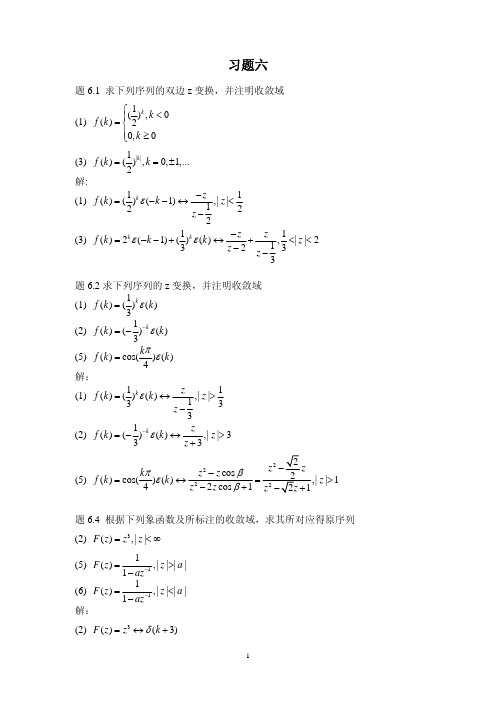
习题六题6.1 求下列序列的双边z 变换,并注明收敛域 (1) 1(),0()20,0k k f k k ⎧<⎪=⎨⎪≥⎩ (3) ||1()(,0,1, (2)k f k k ==± 解: (1) 11()((1),||1222k z f k k z z ε−=−−↔<− (3) 11()2(1)()(),||213233k k z z f k k k z z z εε−=−−+↔+<<−−题6.2求下列序列的z 变换,并注明收敛域 (1) 1()(()3k f k k ε= (2) 1()()()3k f k k ε−=− (5) ()cos()()4k f k k πε= 解: (1) 11()((),||1333k z f k k z z ε=↔>− (2) 1()()(),||333k z f k k z z ε−=−↔>+(5) 222cos ()cos()()|142cos 1z z k z z f k k z z z πβεβ−−=↔=>−+题6.4 根据下列象函数及所标注的收敛域,求其所对应得原序列(2) 3(),||F z z z =<∞ (5) 11(),||||1F z z a az−=>− (6) 11(),||||1F z z a az −=<− 解:(2) 3()(3)F z z k δ=↔+(5) 11(),||||()1k F z z a a k azε−=>↔− (6) 11(),||||(1)1k F z z a a k azε−=<↔−−−− 题6.5 已知2()1,(),()(1)k z z k a k k k z a z δεε↔↔↔−−试利用z 变换的性质求下列序列的z 变换,并注明收敛域。
(2) ()2(4)(8)k k k εεε−−+−(4) (1)(1)k k ε−−(6) 2(1)(1)k k ε−− (8) cos(()2k k πε 解: (2) 48()2(4)(8)2111z z z k k k z z z z z εεε−−−−+−↔−+−−− 48(12)1z z z z −−=−+− 441||01z z z z z−=>− (4) ()()d k k zF z dz ε↔− 2()(1)z k k z ε↔− 1221(1)(1),||1(1)(1)z k k z z z z ε−−−↔=>−− (6) 2133(1)(1)(1)(1)(1)(1)z z z k k z z z ε−++−−↔=−− (8) 2222cos cos()(),||122cos 11k z z z k z z z z πβεβ−↔=>−++题6.9求下列象函数的逆z 变换 (2) 311(),||122z F z z z +=>+232z z ++(6) 2(),||0.5(0.5)(0.25)z F z z z z =>−− 解: (2) 01()3111()22k k F z z z z z z z +==+++ 000()31||2()2z z F z z k z z z ==+=•==+ 1121312|21()2z z z k z z z =++=∗=−+ 2221()**22()()()11222k z F z z z k k z z z δε−=+=−↔+−++ (4) 212()(1)(2)12k k F z z z z z z z z ==+++++ 2111*|1(1)(2)z z z k z z z z =−+==−++ 222(2)*|2(1)(2)z z k z z z z =−=+=++ 22()(1)()2(2)()[(1)2(2)]()12k k k k z z F z k k k z z εεε−=+↔−+−=−+−++ (6) ()(0.5)(0.25)F z z z z z =−− 10.5()(0.5)|2z F z k z z==−= 20.25()(0.25)|1z F z k z z==−=− 211()[2()()]()0.50.2524k k z z F z k z z ε−=+↔−−−题6.11求下列象函数的逆z 变换 (1) 21(),||11F z z z =>+(5) 2(),||1(1)(1)z F z z z z =>−− 解: (1)0122()1(1)k k k F z z z z z z j z j ==+++−+ 00()*|1z F z k z z=== 12()1*()|2z j F z k z j k z ==−=−= 1122()1z zF z z j z j−−=++−+ 1()()2*||cos()*()k f k k k k k δαβθε=++()cos *()2k k k πδε=−(3) ()|1F z z z =>61,2|22j z e π±=±=21()1*()||2233j F z j j k z e z π=−−=−=− 12()2*||cos()cos()()362k f k k e k k k αππβθε=+=+ (5) 1212222()1(1)(1)1(1)1k k k F z z z z z z z ==++−−+−− 11()1*(1)|4z F z k z z =−=+= 2211()1*(1)|2z F z k z z ==−= 2214k =− 2111422(),||11(1)1z z zF z z z z z =++>+−− 1111[(1)]()[(1)21]()4244k k k k k k εε↔−+−=−+−题6.16 用z 变换法求下列非齐次方程的全解(2) ()3(1)2(2)(),(1)0,(2)0.5y k y k y k k y y ε+−+−=−=−=(3) (2)(1)2()(),(0)1,(1)1y k y k y k k y y ε+−+−===解:(2) 121()3[()(1)]2[()(2)(1)]()Y z z Y z y z Y z y y z F z −−−++−++−+−=121()[132][3(1)2(2)2(1)]1z Y z z z y y y z z −−−+++−+−+−=− 3121211()[]13212112k k k z Y z z z z z z z −−=+=++++−−++ 2111(31)1*|2(1)(1)(2)6z z z z k z z z z =−−==−++ 2211(31)1*|2(1)(1)(2)2z z z z k z z z z =−+−==−++ 2322(31)2*|2(1)(1)(2)3z z z z k z z z z =−+−==−−++ 112()[(1)(2)]()623k k y k k ε=+−−− (3) 22()(0)(1)[()(0)]2()1z Y z z z y zy zY z zy Y z z −−−−−=− 22()[2][2]1z Y z z z z z z −−−+−=− 231112()1(1)(1)(2)112k k k Y z z z z z z z z z z −+==++−+−−+− 22221112()111(1)(1)|(1)(2)(2)2z Y z z z z z k z z z z z z =−+−+=−=−==−−−− 21212(21)(2)(1)1|(2)3z z z z z k z =−−−−+==−− 232(2)(1)|1(1)(1)z z z z k z z =−−+==−+ 1132()112z z z Y z z z z −−=++−+− 11()[(1)(2)]()23k k y k k ε=−−−+题6.17 描述某LTI 离散系统的差分方程为()(1)2(2)()y k y k y k f k −−−−=已知1(1)1,(2),()()4y y f k k ε−=−−==,求该系统的零输入响应,零状态响应和全响应。
信号与线性系统第二版答案
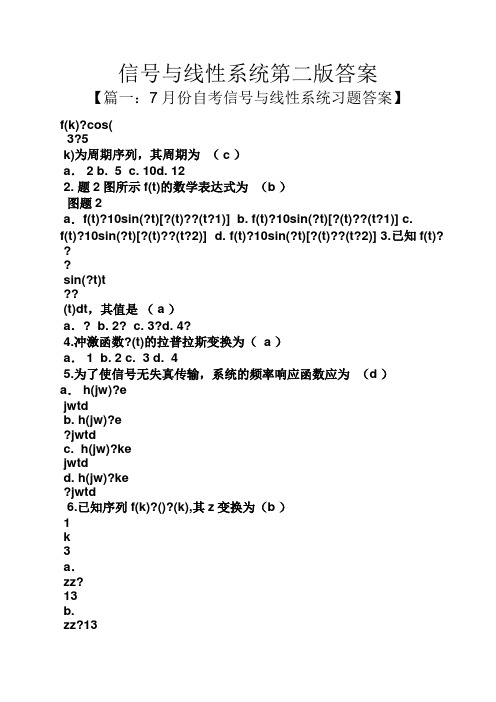
信号与线性系统第二版答案【篇一:7月份自考信号与线性系统习题答案】f(k)?cos(3?5k)为周期序列,其周期为( c )a. 2 b. 5 c. 10d. 122. 题2图所示f(t)的数学表达式为(b )图题2a.f(t)?10sin(?t)[?(t)??(t?1)] b. f(t)?10sin(?t)[?(t)??(t?1)] c.f(t)?10sin(?t)[?(t)??(t?2)] d. f(t)?10sin(?t)[?(t)??(t?2)] 3.已知f(t)? ??sin(?t)t??(t)dt,其值是( a )a.? b. 2? c. 3?d. 4?4.冲激函数?(t)的拉普拉斯变换为( a )a. 1 b. 2 c. 3 d. 45.为了使信号无失真传输,系统的频率响应函数应为(d )a. h(jw)?ejwtdb. h(jw)?e?jwtdc. h(jw)?kejwtdd. h(jw)?ke?jwtd6.已知序列f(k)?()?(k),其z变换为(b )1k3a.zz?13b.zz?13zz?14d.zz?147.离散因果系统的充分必要条件是( a)a.h(k)?0,k?0 b. h(k)?0,k?0c. h(k)?0,k?0 d. h(k)?0,k?0 8.已知f(t)的傅里叶变换为f(jw),则f(t?3)的傅里叶变换为( c )a.f(jw)e b. f(jw)ekjwj2wc. f(jw)ej3wd. f(jw)ej4w9.已知f(k)???(k),h(k)??(k?2),则f(k)?h(k)的值为(b ) a.? k?1?(k?1) b. ?k?2?(k?2) c. ?k?3?(k?3) d. ?k?4?(k?4)10.连续时间系统的零输入响应的“零”是指( a)a. 激励为零b. 系统的初始状态为零c. 系统的冲激响应为零d. 系统的阶跃响应为零 ?11. 已知序列f(k)?ej3k为周期序列,其周期为( c )a. 2 b. 4 c. 6 d. 812. 题2图所示f(t)的数学表达式为(a)ta.f(t)??(t?1)??(t?1)b.f(t)??(t?1)??(t?1) c.f(t)??(t)??(t?1)f(t)??(t)??(t?1)13.已知f1(t)??(t?1),f2(t)??(t?2),则 f1(t)?f2(t)的值是(d )a.?(t) b. ?(t?1) c. ?(t?2)d. ?(t?3)14.已知f(j?)?j?,则其对应的原函数为( b ) a.?(t) b. ?(t) c. ?(t) d. ?15.连续因果系统的充分必要条件是( b )a. h(t)?0,t?0 b. h(t)?0,t?0 c. h(t)?0,t?0 d. h(t)?0,t?0 16.单位阶跃序列?(k)的z变换为( d )a.zz?1,z?1 b. zz?1,z?1 c. zz?1,z?1 d. zz?1,z?1 17.已知系统函数h(s)?1s,则其单位冲激响应h(t)为(a )a.?(t) b. t?(t) c. 2t?(t) d. 3t?(t)18.已知f(t)的拉普拉斯变换为f(s),则f(5t)的拉普拉斯变换为(c)a.f(s) b. 1s1s53f(5) c. 5f(5) d. 1s7f(5) 19.已知f(k)??k?2?(k?2),h(k)??(k?2),则f(k)?h(k)的值为( d )a.?k?1?(k?1)b. ?k?2?(k?2) c. ?k?3?(k?3) d. ?k?4?(k?4)20.已知f(t)的傅里叶变换为f(j?),则f(jt)的傅里叶变换为( c )d.a. ?f(??)b. ?f(?)c. 2?f(??)d. 2?f(?)21. 下列微分或差分方程所描述的系统是时变系统的是(b)a. y(t)?2y(t)?f(t)?2f(t)b. y(t)?sinty(t)?f(t)c. y(t)?[y(t)]?f(t)d.y(k)?y(k?1)y(k?2)?f(k)22. 已知f1(t)?t?(t),f2(t)??(t),则f1(t)?f2(t)的值是( c)a.0.1t?(t) b. 0.3t?(t) c. 0.5t?(t)d. 0.7t?(t)23.符号函数sgn(t)的频谱函数为( b )22222a.1234b.c.d. j?j?j?j?24.连续系统是稳定系统的充分必要条件是( a ) a.???h(t)?mb.????h(t)?mc.????h(t)dt?md.????h(t)dt?m25.已知函数f(t)的象函数f(s)?(s?6),则原函数f(t)的初值为(s?2)(s?5)(b )a. 0b. 1 c. 2 d. 3 26.已知系统函数h(s)??t?t3,则该系统的单位冲激响应为( c) s?1?t?ta.e?(t) b.2e?(t) c.3e?(t) d. 4e?(t) 27.已知f(k)??kk?1?(k?1),h(k)??(k?2),则f(k)?h(k)的值为( d )k?1a.??(k) b.??(k?1) c.?k?2?(k?2) d. ?k?3?(k?3)28. 系统的零输入响应是指( c )a.系统无激励信号b. 系统的初始状态为零c. 系统的激励为零,仅由系统的初始状态引起的响应d. 系统的初始状态为零,仅由系统的激励引起的响应 29.偶函数的傅里叶级数展开式中( b )a.只有正弦项 b.只有余弦项c. 只有偶次谐波 d. 只有奇次谐波 30. 已知信号f(t)的波形,则f()的波形为(b )a.将f(t)以原点为基准,沿横轴压缩到原来的c. 将f(t)以原点为基准,沿横轴压缩到原来的t21214b. 将f(t)以原点为基准,沿横轴展宽到原来的2倍d. 将f(t)以原点为基准,沿横轴展宽到原来的4倍简答题.。
信号与线性系统分析课后答案吴大正
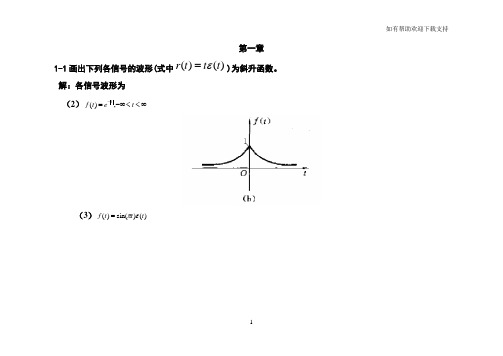
1第一章1-1画出下列各信号的波形(式中)()(t t t r ε=)为斜升函数。
解:各信号波形为 (2)∞<<-∞=-t e t f t ,)((3))()sin()(t t t f επ=(4))fε=t(t(sin)(5))tf=(sinr(t)2(7))tf kε(k=(2)(10))f kεk-=(k+]()1()1[341-2 画出下列各信号的波形[)()(t t t r ε=为斜升函数]。
(1))2()1(3)1(2)(-+--+=t t t t f εεε (2))2()1(2)()(-+--=t r t r t r t f(5))2()2()(t t r t f -=ε (8))]5()([)(--=k k k k f εε(11))]7()()[6sin()(--=k k k k f εεπ (12))]()3([2)(k k k f k---=εε 解:各信号波形为 (1))2()1(3)1(2)(-+--+=t t t t f εεε(2))2()1(2)()(-+--=t rt rt rtf(5))2()2()(ttrtf-=ε56(8))]5()([)(--=k k k k f εε(11))]7()()[6sin()(--=k k k k f εεπ(12))]()3([2)(kkkf k---=εε71-3 写出图1-3所示各波形的表达式。
81-4 写出图1-4所示各序列的闭合形式表达式。
9101-5 判别下列各序列是否为周期性的。
如果是,确定其周期。
(2))63cos()443cos()(2ππππ+++=k k k f (5))sin(2cos 3)(5t t t f π+=解:111-6 已知信号)(t f 的波形如图1-5所示,画出下列各函数的波形。
(1))()1(t t f ε- (2))1()1(--t t f ε (5))21(t f - (6))25.0(-t f(7)dtt df )( (8)dx x f t ⎰∞-)(解:各信号波形为 (1))()1(t t f ε-12(2))1()1(--t t f ε(5))21(t f -13(6))25.0( t f(7)dt t df )((8)dxxft⎰∞-)(14151-7 已知序列)(k f 的图形如图1-7所示,画出下列各序列的图形。
(完整版)信号与线性系统分析吴大正习题答案
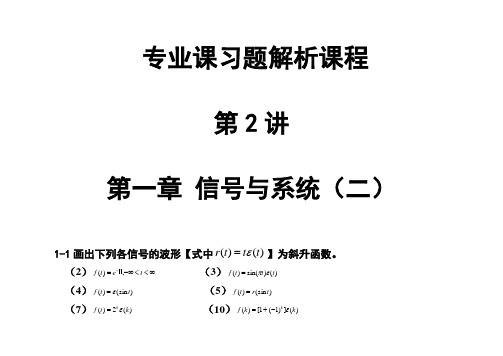
专业课习题解析课程第2讲第一章 信号与系统(二)1-1画出下列各信号的波形【式中)()(t t t r ε=】为斜升函数。
(2)∞<<-∞=-t et f t,)( (3))()sin()(t t t f επ=(4))(sin )(t t f ε= (5))(sin )(t r t f = (7))(2)(k t f kε= (10))(])1(1[)(k k f kε-+=解:各信号波形为 (2)∞<<-∞=-t et f t,)((3))()sin()(t t t f επ=(4))(sin )(t t f ε=(5))tf=r(t(sin)(7))f kε=t(k2)((10))(])1(1[)(k k f k ε-+=1-2 画出下列各信号的波形[式中)()(t t t r ε=为斜升函数]。
(1))2()1(3)1(2)(-+--+=t t t t f εεε (2))2()1(2)()(-+--=t r t r t r t f(5))2()2()(t t r t f -=ε (8))]5()([)(--=k k k k f εε (11))]7()()[6sin()(--=k k k k f εεπ(12))]()3([2)(k k k f k---=εε 解:各信号波形为(1))2()1(3)1(2)(-+--+=t t t t f εεε(2))2()1(2)()(-+--=t r t r t r t f(5))2()2()(t t r t f -=ε(8))]5()([)(--=k k k k f εε(11))]7()()[6sin()(--=k k k k f εεπ(12))]()3([2)(kkkf k---=εε1-3 写出图1-3所示各波形的表达式。
1-4 写出图1-4所示各序列的闭合形式表达式。
1-5 判别下列各序列是否为周期性的。
如果是,确定其周期。
信号与线性系统课后习题答案5

1 −( s+1) 1 1 ,∴ LT [ε (t − 1)] = e − s ,∴ LT [e −t ε (t − 1)] = e s s +1 s
d 1 −( s+1) s + 2 −( s − 2 ) [ ]= e e ds s + 1 ( s + 1) 2
∴ LT [te −(t −3)ε (t − 1)] = −e3
1 [sin(2t ) − cos(2t )]ε (t ) 2 2 1 s ( 2 ) − 2 2 s +4 s +4
, ∫ sin(πx)dx = ∫ sin(πx)ε ( x)dx
0
∴ LT [sin(2t − π / 4)ε (t )] =
(9) Q LT [sin(πt )ε (t )] =
∞ 1 2 1 ∴F ( s ) = ∫ f (t )e −st dt = − e −s + e −2 s 0− s s s
(e)
Q f (t ) =
2 2 t[ε (t ) − ε (t − T / 2)] − (t − T )[(ε (t − T / 2) − ε (t − T )] T T
∞
∴F ( s ) = ∫
5
sy (0−) + y′(0−) + 3 y (0−) s+4 + 2 F (s) , 2 s + 3s + 2 s + 3s + 2 1 1 1 sy (0−) + y′(0−) + 3 y (0−) Yx ( s ) = , = 2 = − 2 s + 3s + 2 s + 3s + 2 s + 1 s + 2 1 2 3 1 s+4 s+4 , Y f ( s) = 2 F ( s) = 2 × = − + s + 3s + 2 s + 3s + 2 s s s + 1 s + 2 Y (s) =t2 Nhomakorabeaπ
- 1、下载文档前请自行甄别文档内容的完整性,平台不提供额外的编辑、内容补充、找答案等附加服务。
- 2、"仅部分预览"的文档,不可在线预览部分如存在完整性等问题,可反馈申请退款(可完整预览的文档不适用该条件!)。
- 3、如文档侵犯您的权益,请联系客服反馈,我们会尽快为您处理(人工客服工作时间:9:00-18:30)。
实验一 连续信号的时域分析 (3)实验二 连续时间系统的时域分析 (8)实验三 连续信号的频域分析 (14)实验四 连续系统的频域分析 (22)实验五 信号采样与重建 (33)实验六 离散时间信号和系统分析 (39)实验总结 (46)实验一 连续信号的时域分析1、源程序:syms t;f1=2*exp(t);f2=2*cos(3*t+4);f3=2*sin(3*t+4);ezplot(f1,[-10,2]);xlabel('t');title('f(t)=2e^t');grid on;ezplot(f2,[-5,5]);xlabel('t');title('f(t)=2cos(3t+4)');grid on;ezplot(f3,[-5,5]);xlabel('t');title('f(t)=2sin(3t+4)');grid on2、。
源程序:t=-5:0.01:5;f1=sinc(t);f2=3*rectpuls(t,4);f3=3*tripuls(t,4,0);subplot(2,2,1);plot(t,f1);xlabel('t');title('f(t)=sinc(t)');grid on;subplot(2,2,2)plot(t,f2);xlabel('t');title('f(t)=3rectpuls(t,4)');grid on;axis([-5,5,-1,4]);subplot(2,2,3);plot(t,f3);xlabel('t');title('f(t)=3rectpuls(t,4,0)');grid on;axis([-5,5,-1,4]);3、t1=-14:0.05:2;t2=0:0.05:16;t=-6.5:0.05:1.5;t4=-6:0.05:26;f1=4*rectpuls(-t1-6,12)+3*tripuls(-t1-6,4,0);f2=4*rectpuls(t2-8,12)+3*tripuls(t2-8,4,0);f3=4*rectpuls(1-2*t-6,12)+3*tripuls(1-2*t-6,4,0); f4=4*rectpuls(0.5*t4+1-6,12)+3*tripuls(0.5*t4+1-6,4,0);plot(t1,f1);xlabel('t');title('f(-t)');plot(t2,f2);xlabel('t');title('f(t-2)');plot(t,f3);xlabel('t');title('f(1-2t)');plot(t4,f4);xlabel('t');title('f(0.5t+1)');实验二 连续时间系统的时域分析四、实验内容源程序:方法一:t=0:0.01:10;f=exp(-t);a=[1 2];b=[1];y=lsim(b,a,f,t);plot(t,y);xlabel('Time(sec)');ylabel('i(t)');axis([0,10,-0.025,0.275]);grid on;方法二:syms t x;e=exp(-x);h=exp(-2.*(t-x));i=int(e.*h,x,0,t);ezplot(i,[0,10]);xlabel('Time(sec)');ylabel('i(t)');title('exp(-t)*exp(-2t)');grid on;2. 求上述系统的冲激响应与阶跃响应。
冲激响应源程序:clear;close;clc;a=[1 2];b=[1];impulse(b,a,10);xlabel('Time(sec)');ylabel('i(t)');axis([0,10,-0.1,1]);grid on;阶跃响应源程序:clear;close;clc;a=[1 2];b=[1];step(b,a,10);xlabel('Time(sec)');ylabel('i(t)');axis([0,10,0,0.55]);grid on;五、思考题1. 为什么连续时间系统的零状态响应为激励与冲击响应的卷积?答:根据卷积的定义,函数e(t)与函数h(t)相卷积后,就是在变量由负无穷到正无穷范围内,对于某一t值时乘积e(τ)h(t-τ)曲线下的面积,也就是:r(t)=e(t)*h(t),又零状态响应与系统的特性和外加激励有关,所以如问题。
2. 利用卷积积分法计算系统响应应从几个方面进行?答:利用卷积积分法先要将系统的冲击响应求出,之后再将其与激励卷积即可实验三 连续信号的频域分析四、实验内容1.syms t n;T=2*pi; %设T为2*piN=9; %设N为9f=heaviside(t)-2*heaviside(t-T/2)+heaviside(t-T); subplot(2,2,1);ezplot(f,[0,2.1*pi]);title('原函数');h=exp(-j*n*2*pi/T*t); %用指数傅里叶级数表示,角频率2*pi/T A1=int(f.*h,t,0,T);A=2/T*A1;for n1=-N:-1C(n1+10)=subs(A,n,n1);endfor n1=1:NC(n1+10)=subs(A,n,n1);endC(10)=0;%N=0时系数subplot(2,2,3);k=-N:N;stem(k,abs(C)); %作出幅度谱ylabel('Cn 的幅度');xlabel('\Omega');subplot(2,2,4);stem(k,angle(C)); %作出相位谱ylabel('Cn的相位');xlabel('\Omega');f1=0;for m=-N:Nf1=f1+1/2*C(m+10)*exp(j*m*t);%前N次谐波合成的信号近似endsubplot(2,2,2);ezplot(f1,[0,2.01*pi]);title('前N次谐波合成的信号近似');2、源程序:clearcloseclcsyms t x ;x=fourier(t*exp(-3*t)*heaviside(t)); xz=abs(x);ezplot(z);%符号函数作图函数xlabel('Time(sec)');ylabel('|F(jω)|');grid on得F(jω)= 1/(3+ j*ω)^2(2) 源程序:clearcloseclcsyms t x ;x=fourier(2*heaviside(t)-1);%2*heaviside(t)-1即为sgn(t)xz=abs(x);ezplot(z);%符号函数作图函数xlabel('Time(sec)');ylabel('|F(jω)|');grid on得F(jω)= -2*j/ω3、Fm=10;t1=0:0.00002:0.2;syms t v;x=sin(2.0*pi*Fm*t)/(2.0*pi*Fm*t); subplot(3,2,1);ezplot(x,[0,0.2]);title('原函数');Fx=fourier(x,v);subplot(3,2,2);ezplot(Fx,[-50*pi,50*pi]);axis([-50*pi,50*pi,-0.05,0.1]); title('频谱');y=x*cos(200*pi*t);subplot(3,2,3);b=subs(y,t,t1);plot(t1,b);title('调制后');axis([0,0.2,-1,1]);Fy=fourier(y,v);subplot(3,2,4);ezplot(Fy,[-250*pi,250*pi]);axis([-250*pi,250*pi,-0.05,0.1]);title('频谱');z=y*cos(200*pi*t);Fz=fourier(z,v);G=-heaviside(v-20*pi)+heaviside(v+20*pi);%门函数Fx1=Fz*G;x1=2*ifourier(Fx1,v);%滤波过程中幅度减半且反向。
subplot(3,2,5);ezplot(x1,[0,0.2]);title('解调后');subplot(3,2,6);ezplot(2*Fx1,[-50*pi,50*pi]);axis([-50*pi,50*pi,-0.05,0.1]);title('频谱');五、思考题1、根据试验1 的结果,解释Gibbs 现象。
答:因为对于具有不连续点的函数,即使级数的项无限增大,在不连续处,级数之和不收敛于函数f(t);在跃变点附近的波形,总是不可避免的存在有起伏震荡,从而使跃变点的值超过一形成过冲,造成吉布斯现象。
2、比较周期信号与非周期信号的频谱。
区别:1.周期信号的频谱为离散频谱,非周期信号的频谱为连续频谱。
2.周期信号的频谱为Fn的分布,表示每个谐波分量的复振幅;而周期信号的频谱为F(jω)的分布,(F(jω)/2)ω表示合成谐波分量的复振幅,所以也将称为频谱密度函数。
联系:1.都是反映将时域信号表示为正弦类信号时各谐波分量的分布特性。
2.若周期信号是连续非周期信号的周期延拓,则两者的关系为F(jω)= ; =3、调制与解调的基本原理是什么?为什么要进行调制?调制:调制就是使信号f(t)控制载波的某一个或某些参数(如振幅、频率、相位等),是这些参数按照信号f(t)的规律变化的过程。
载波可以是正弦波或脉冲序列。
以正弦型信号作载波的调制叫做连续波调制。
调制后的载波就载有调制信号所包含的信息,称为已调波。
对于连续波调制,已调信号可以表示为:它有振幅频率和相位三个参数构成。
改变三个参数中的任何一个都可以携带同样的信息。
因此连续波的调制可分为调幅、调相、和调频。
解调:解调是调制的逆过程,它的作用是从已调波信号中取出原来的调制信号。
